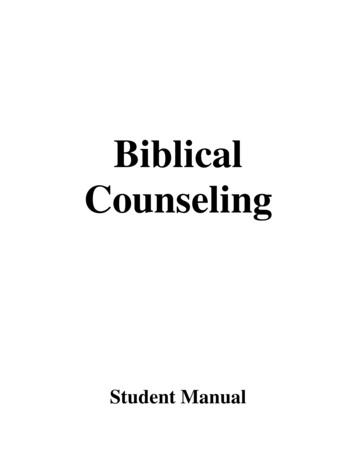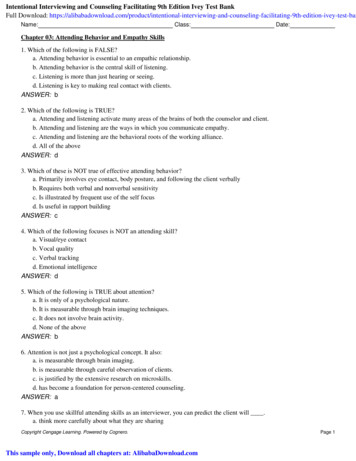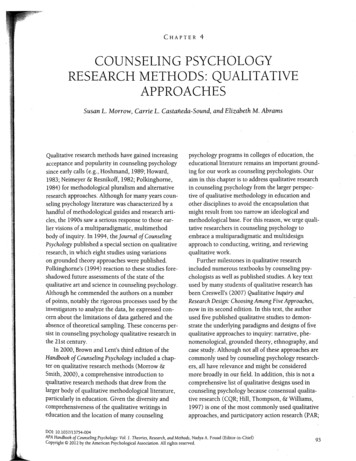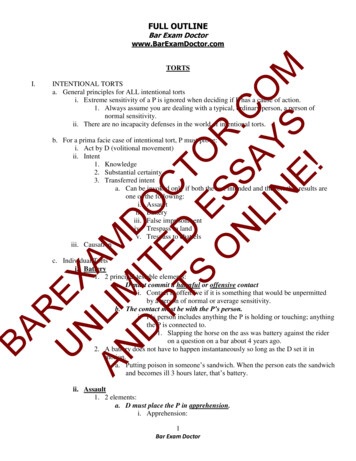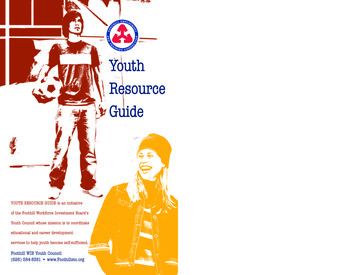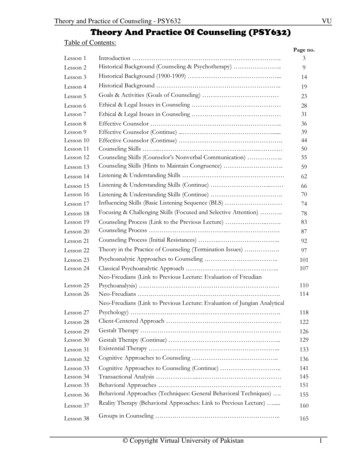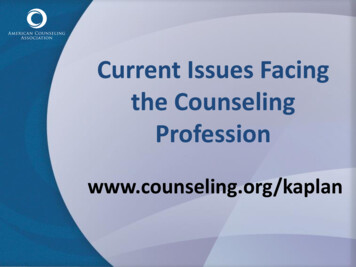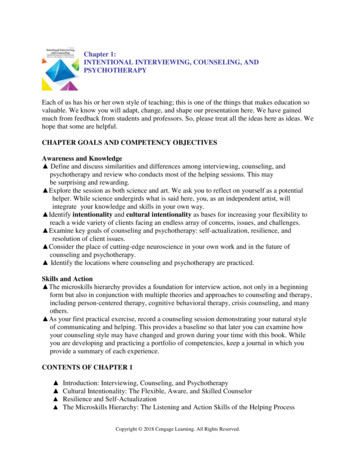
Transcription
Chapter 1:INTENTIONAL INTERVIEWING, COUNSELING, ANDPSYCHOTHERAPYEach of us has his or her own style of teaching; this is one of the things that makes education sovaluable. We know you will adapt, change, and shape our presentation here. We have gainedmuch from feedback from students and professors. So, please treat all the ideas here as ideas. Wehope that some are helpful.CHAPTER GOALS AND COMPETENCY OBJECTIVESAwareness and Knowledge Define and discuss similarities and differences among interviewing, counseling, andpsychotherapy and review who conducts most of the helping sessions. This maybe surprising and rewarding. Explore the session as both science and art. We ask you to reflect on yourself as a potentialhelper. While science undergirds what is said here, you, as an independent artist, willintegrate your knowledge and skills in your own way. Identify intentionality and cultural intentionality as bases for increasing your flexibility toreach a wide variety of clients facing an endless array of concerns, issues, and challenges. Examine key goals of counseling and psychotherapy: self-actualization, resilience, andresolution of client issues. Consider the place of cutting-edge neuroscience in your own work and in the future ofcounseling and psychotherapy. Identify the locations where counseling and psychotherapy are practiced.Skills and Action The microskills hierarchy provides a foundation for interview action, not only in a beginningform but also in conjunction with multiple theories and approaches to counseling and therapy,including person-centered therapy, cognitive behavioral therapy, crisis counseling, and manyothers. As your first practical exercise, record a counseling session demonstrating your natural styleof communicating and helping. This provides a baseline so that later you can examine howyour counseling style may have changed and grown during your time with this book. Whileyou are developing and practicing a portfolio of competencies, keep a journal in which youprovide a summary of each experience.CONTENTS OF CHAPTER 1 Introduction: Interviewing, Counseling, and Psychotherapy Cultural Intentionality: The Flexible, Aware, and Skilled Counselor Resilience and Self-Actualization The Microskills Hierarchy: The Listening and Action Skills of the Helping ProcessCopyright 2018 Cengage Learning. All Rights Reserved.
Neuroscience and Neurobiology: Implications of Cutting-Edge Science for the Future of Counseling and PsychotherapyOffice, Community, Phone, and Internet: Where Do We Meet Clients?Your Natural Helping Style: Establishing Your BaselineKey Points: The Art of Applying and Taking Action as You Work Through this BookPortfolio of Competencies and Personal ReflectionOVERVIEW OF CHAPTER 1Chapter 1 offers an overview and a road map of what this book can do for you and your students.It begins with definitions of interviewing, counseling, and psychotherapy. The microskillshierarchy and an outline of the competencies to be achieved in the book follow. Development isstressed as the aim of interviewing and counseling. This chapter also outlines culturalintentionality and cross-cultural applications of the skills approach. The teaching model ofmicroskills is outlined. Research validation of the model and relevant content on neurology andbrain research are introduced. Finally, suggestions for the first audiotape or videotape transcriptare presented.MINDTAP FOR INTENTIONAL INTERVIEWING AND COUNSELING:FACILITATING CLIENT DEVELOPMENT IN A MULTICULTURAL SOCIETYMindTap for Intentional Interviewing and Counseling: Facilitating Client Development in aMulticultural Society, 9th edition, engages and empowers students to produce their best work. Byseamlessly integrating course material with videos, activities, apps, and much more, MindTapcreates a unique learning path that fosters increased comprehension and efficacy. Each chapter ofthe MindTap includes activities to help students answer the following questions: Why am I here?o Chapter opening polling activity What am I learning?o Chapter readingo Quiz: Did I get it? How do I practice what I’ve learned? (various activities included for each chapter)o Video activitieso Practice activitieso Case studieso Helper Studio What does this mean to me?o Reflection activityDEMONSTRATIONS, FILM, AND VIDEO SUGGESTIONS Basic Attending Skills has a brief introductory lecture on microskills by Allen Ivey. Counseling Children: A Microskills Approach by Mary Bradford Ivey shows how microskillsare used with children. If the class includes many elementary school counselors, this will beespecially helpful. A brief example is presented in the MindTap.Copyright 2018 Cengage Learning. All Rights Reserved.
Counseling: An Indigenous Perspective by David Rathman discusses how indigenous peopleconceptualize the helping process. Although the text is written from an Australianperspective, it is well received and understood by students outside of Australia. Video Activity: Demystifying the Helping Process. Watch the video and answer the questions.The video recommendations mentioned here are available from Alexander StreetPress/Microtraining. The website is -therapyvideo-series. ASP/Microtraining offers a constant new stream of videos that you will want toexamine. You can contact them for a free exploratory session to preview some videos.CLASS PROCEDURESDifferent instructors use different procedures according to their class organization. Some preferto begin with a discussion of the similarities and differences among interviewing, counseling,and psychotherapy. Some like to introduce ethical coaching at this time. Others begin with adiscussion of the microskills hierarchy. Usually, intentionality and culture are introduced tohighlight the importance of cultural and contextual issues in helping others. The following iswhat we do when we want to cover the most important ideas of the chapter.1. Lecture/discussion of interviewing, counseling, and psychotherapy. We use a brief lecturebased on the associated PowerPoints to introduce interviewing, coaching, counseling, andpsychotherapy. We follow up with a discussion about the similarities and differences amongthese professional activities. We engage students in an active discussion of the topic andsummarize and link their responses to each of these four activities. You may wish to divide yourclass into small groups and have each group discuss the similarities and differences among theseactivities and report back to the class. We follow up with a discussion of microskills used inthese activities by coaches, counselors, and psychotherapists. We think that starting the class byhighlighting the fact that all professionals use the microskills to some degree is important.2. The Microskills Hierarchy. Central to the lecture and discussion is introduction of theMicroskills Hierarchy, which provides students with an outline of the competencies they willachieve in the course. We have found that the structure of the Microskills Hierarchy helpsstudents become more competent in all theories of counseling and therapy and increases theirsense of how to use skills and strategies with clients.Copyright 2018 Cengage Learning. All Rights Reserved.
3. Model for learning microskills. We explain that the model for learning microskills is practiceoriented and follows a step-by-step progression, and we invite students to briefly try the model,as it will appear throughout the course as a basic learning framework.The model includes the following steps:1. Introduction. Focus on a single skill or strategy and identify it as a vital part of thehelping process.2. Awareness, Knowledge, and Skills. Read about the single skill or strategy and/or hear alecture on the main points of effective use from your instructor. Cognitive understandingis vital for skill development. However, understanding is not competence, nor does itshow that you can actually engage in an effective interview, counseling, or therapysession.3. Observation. View the skill in operation via a transcript and process analysis—or betteryet, watch a live demonstration or view a videotaped presentation.4. Multiple Applications. Review different applications of the skill or strategy, variationsaccording to diversity and other cultural dimensions, and additional ways in which theskill or strategy can be used.5. Action: Key Points and Practice. Ideally, use video or audio recording for skill practice;however, role-playing practice with observers and feedback sheets is also effective. Seekimmediate feedback after your practice session. Use the Feedback Sheets. How did thosewho watched the session describe your interaction?Copyright 2018 Cengage Learning. All Rights Reserved.
6. Portfolio of Competencies and Personal Reflection. Develop a summary of yourinterviewing, counseling, and psychotherapy abilities. You will be asked to summarizethe meaning of the chapter for practice now and in the future.We believe it is important to help students understand that they can “go through” the skillsquickly and understand them, but practicing them to achieve full mastery results in real expertise.5. Cultural Intentionality. A lot can be done with this chapter, and covering every issue will be achallenge. However, a discussion of concepts such as intentionality — which asks students to bethemselves but also to realize that they need to be flexible and constantly learn new ways ofinteracting with clients during interviews — is very important.6. Viewing of an interview video. We like to show the full version of the Basic Attending Skills.This video provides an effective introduction to the listening skills. Furthermore, it providespositive and negative examples of each skill. We follow the video presentations with brief roleplays demonstrating the negative and positive applications of the skill. You may also wish toshow and discuss the MindTap videos on your laptop with your students.7. Neuroscience and neurobiology. If possible, or if you have more than 3 hours to spend on thiscontent, a discussion of the implications of brain research for the interview is in order. Theevidence that effective counseling and therapy can produce new neurons in the brain is clear.Discussion of neuroscience findings provides a novel validation of the work we do, and studentsappreciate it.8. Your Natural Style: An Important Audio or Video Exercise. Students have a natural style ofcommunicating, and the concepts presented in the book should be used to supplement thatnatural style. The goal is for students to learn new skills while being themselves. The first audioor video recording using the student’s natural communication style during an interview will helphim or her obtain an accurate picture of where he or she is at the start of this course. Studentswill want to compare their first interview with later work as they progress through this course.Their natural style is a baseline they will want to keep in touch with and honor.DISCUSSION OF COMPETENCY PRACTICE EXERCISESExercise. Your Natural Helping Style. We believe this exercise is one of the most important inthe book. Students have a natural style of communicating, and it is that natural style and theirsocial skills on which they need to build. We want them to learn these helping skills whilemaintaining their natural style. We seek authenticity, not actors playing a role.Critical to student success is the use of the Client Feedback Form presented in Chapter 1.Self-Assessment and Portfolio of Competence. We suggest creating a journal assignment andspace for students to identify their level of competence in relation to the concepts presented inthe chapter. On the MindTap companion website, students can find a downloadable form to becompleted and added to the portfolio for future chapters.Copyright 2018 Cengage Learning. All Rights Reserved.
KEY POINTSEach chapter features a list of key points. Chapter 1 key points are as follows: Interviewing, Counseling, and Psychotherapy Counseling Is Both Science and Art Cultural Intentionality Resilience and Self-Actualization Microskills and Microskills Hierarchy Neuroscience/Neurobiology and Stress Places Where We Meet Clients Your Natural Helping StyleDISCUSSION QUESTIONS1. Discuss the microskills presented in the Microskills Hierarchy. What are your thoughts aboutthe way they are organized in the Microskills Hierarchy?2. With which microskills are you most familiar? About which microskills would you like tolearn more?3. How competent do you feel about incorporating microskills into your practice? What are sometechniques you might use to master these microskills?WEB LINKSNational Center for PTSDA comprehensive view of issues of trauma.http://www.ptsd.va.gov/American Academy of Experts in Traumatic StressAnother comprehensive source of information on trauma.http://www.aaets.org/UCLA Center for Mental Health in SchoolsClick for information on working with children on issues of crisis and trauma.http://smhp.psych.ucla.edu/American Academy of PediatricsHelping children and adolescents deal with Copyright 2018 Cengage Learning. All Rights Reserved.
The Center for Mental Health ServicesThe Substance Abuse and Mental Health Services Administration (SAMHSA) providesresources for supporting its mission to reduce the impact of substance abuse and mental illnesson America's communities.http://store.samhsa.gov/homeCopyright 2018 Cengage Learning. All Rights Reserved.
It begins with definitions of interviewing, counseling, and psychotherapy. The microskills hierarchy and an outline of the competencies to be achieved in the book follow. Development is stressed as the aim of interviewing and counseling. This chapter also outlines cultural intentionality and cross-cultural applications of the skills approach.
